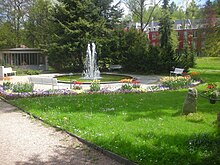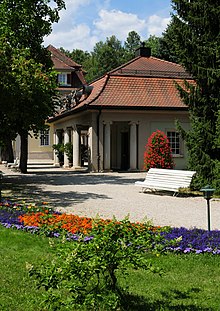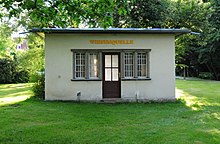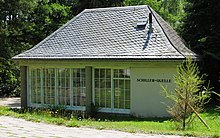Bad Brambach spa gardens
The Bad Brambach spa park was created in 1912 in what was then Unterbrambach at the instigation of the already resident sparkling water company as a result of the fact that table water has been regularly bottled in its place since 1890 . The horticulturally designed spa area of Bad Bramstedt particularly developed with its existing buildings in several stages and stands today as impersonal entity "park and spa complex" under monument protection . The spa park extends over an area of about 16 hectares and borders on the territory of the Czech Republic .
location
The approximately 20 hectare spa park area is located in a valley depression of the Röthenbach ( Plesná ) coming from the west in the Saxon part of the Elster Mountains . At the lower border spring in the spa park and a border corner between the countries of Germany and the Czech Republic, it takes up the Ehrbach ( Starý potok ) flowing to the left . In the upper part of the valley, the grounds of the spa park are still close to nature and have a few paths through them. At the Lower Grenzquelle, the area down the valley takes on a park-like character, which is also evident in the layout of the paths and the stock of ornamental trees. The spa park stretches down the valley towards the center of Bad Brambach and ends at its architectural highlight, the festival hall with its horticultural pond in front. On the north flank of the valley, further areas extend upwards with partially publicly accessible green spaces and younger buildings.
In the valley floor in the predominantly loamy sediment layers there are lenticular boggy - peaty deposits.
The spa park area is traversed along its length by two almost parallel streets; in the north the Oberreuther Strasse and in the south the Badstrasse. Overall, the spa park is located in the western part of the village and is on the north-south trunk road B92 . The traffic development is therefore from the center of Schönberger Straße via the Badstraße branching off from it. The railway line Railway line Plauen – Cheb borders immediately to the south of the spa park area; there is no stopping point here. The Bad Bramstedt station is nearby arrival and departure point for train travelers.
The place name with the addition "Bad" has existed since 1922.
Single description
Used mineral water sources
The first documentary evidence of the use of the Brambacher springs for drinking purposes is documented for the year 1678, according to which " bottling " is said to have already been carried out at this time .
On a historical map, the Meilenblatt (Berlin copy) from 1793, it can be seen in the area of the later spa park that several ponds were created in this water-rich area and the natural headwaters west of Unterbrambach were already known with the field name "Sauerbrunn". This note can also be found on later measuring table sheets (1: 25,000) up to around 1900. On the Saxon measuring table sheet from 1903, the note “Schiller Qu.” Is entered at this point. The waterworks registered in the measuring table sheet ( sheet Bad Elster ) from 1922 on the northern flank of the valley depression in the direction of the Hengstberg indicates the abundance of water in the area.
The following sources have become known (left / right denotes the location on the Röthenbach):
- Obere Grenzquelle (r), drilled in 1928, approx. 105 m deep.
- Lower border spring (r), drilled in 1928, approx. 200 m deep.
- Schillerquelle (l), the old community spring , the dispatch of table water was stopped in 1959. The name was chosen by a tenant because of the similarity to the Schüller spring.
- Eisenquelle (l), also named Schüllerquelle after Johann Matthäus Schüller, Sauerbrunn known since 1860, since 1890 as table water in the trade.
- Wettinquelle (r), also called Radonquelle or Neue Quelle, discovered in January 1911 during construction work on the filling and mail order house and secured in the first quarter of 1911 with a 6 m deep well shaft. It was named Wettinquelle in 1912.
- Wiesenquelle (r) is located about 60 m down the valley from the Wettin spring within the spa park and has its own spring house.
also in the valley area of the Röthenbach:
- Sprudel I (r), drilled in 1906/1907 (was used for table water until 1937, Brambacher Sprudel).
- Sprudel II (r), drilled in 1906/1907 (was used for table water until 1937, Brambacher Sprudel).
- Well drilling between Vogtlandhaus and Fritz-Rödiger-Haus (r), drilled in 1937 and used for bottling table water until after 1964.
Further sources emerged which were opened up by drilling work. In the Vogtland dialect, "Saaling" is used as a source name for a natural sourling .
building
- Festival hall at the Schwanenteich
- The festival hall at the pond forms the end of the horticulturally sophisticated spa facilities. It was built around 1930. The building with a concert square facing the pond is used for events in the spa gardens.
- Vogtlandhaus (previously a spa hotel), a three-wing spa house
- The Vogtlandhaus was built between 1926 and 1928 on the site of the former spa hotel, which had to give way to a filling and mail order company around 1911.
- The existing building was erected as a rectangular, two-wing complex that is kept open to the east. Together with the Wettin spring fountain house built in 1912, it marks the architectural starting point within the spa facilities. The connection between a new spring house (Wettin spring) and the Vogtland house through expansion work was established in 1929.
- Quellhaus Wettinquelle with a walkway
- Originally there was a wooden house here to protect the spring. This well house existed when the baths opened on May 1, 1912 and existed until 1929. In its place has been the source temple since 1929 with the connected walkway, the roof of which is supported by two rows of Ionic columns . There were further structural alterations from 1957 to 1959.
- Vogtland residence (formerly Grenzwacht house, later Julius Fučik house)
- The former Julius Fučik House was built between 1937 and 1938 and forms a dominant structural end on the northwest side of the spa park. It serves as a clinic building.
- Aquadon
- The "Aquadon" was built in the 1990s as a therapy and wellness center with swimming pool and sauna village on behalf of the Sächsische Staatsbäder GmbH. Comprehensive renovation work will take place in these buildings in 2020. In addition, the spa facilities of the Saxon state baths are being expanded with a new building.
- Parkhotel
- The Parkhotel is a building from the 1990s that is used for accommodation purposes and is located opposite the Schwanenteich near the festival hall and on the edge of the Kurpark grounds. It is operated privately.
- Joliot Curie House (formerly Weidig House, later Radium Kurhof)
- The building of the Joliot Curie House is one of the early buildings in the park area and was initially called the Weidig House. Its use began in the spring of 1913. The redesign and structural expansion took place in 1936, with it the renaming to Radium-Kurhof. Further structural changes were made in 1959. It once served as a clinic building; but has stood empty since the 1990s and is in ruins.
- Fritz-Rödiger-Haus (formerly Bose House )
- This building, built in 1912, is made entirely of wood and has a slate roof. Its architecture is characterized by the country house style.
- Source house of the Schiller spring
- The square building stands a few meters west of the iron source and is currently not used for visitors.
- Spring house of the meadow spring
- The building is located on a meadow between the Wettin spring and the swan pond. It is not accessible to visitors.
- Spring house of the iron spring (Schüller spring , Sauerbrunn)
- The small pavilion in the style of New Objectivity is in the center of the park. After 1945, its interior was equipped with natural stone slabs , which are said to come from the Reich Chancellery building in Berlin , which was destroyed in the war . There is a publicly usable wall well with continuous water pouring from the iron source.
- Source house of the lower border spring
- This source is used to draw water for bathing purposes. It was drilled in 1928/1930.
- Spring house of the Upper Border Spring
- This source is used to draw water for bathing purposes. It was drilled in 1928/1930.
- Stone arch bridge
- The stone arch bridge, a quarry stone structure, spans the Röthenbach at the Lower Grenzquelle.
- Forest cafe
- The forest café is located away from the spa park in the densely wooded Sorgebach Valley (Zankbächl) between the Röthenbach group of houses and the neighboring Hohendorf . It is a rotunda from the 20th century. As a result of an investigation from 1926, the noticeable radon content of the air in the valleys of the Röthenbach and the Zankbächl was recognized because the noble gas escapes from the soil in these areas. The inhalation of radon by the spa guests during their stay in the landscape was previously considered to be a specific component of the spa effect of the spa.
Horticultural plants
The parks take up an area of 16 hectares and are under monument protection. At its natural edge areas, the area turns into a landscape park. The path system in the park area is integrated into the regional network of hiking trails around Bad Brambach.
The reliably documented origins point to the year 1892 and are based on the work of the head gardeners Walter Karwowsky and Willy Landrock. The festival hall and the swan pond in front of it form an architectural and horticultural area in the style of an English landscape garden with the well-tended plantings and the well houses located therein . The woody stock is characterized by numerous rhododendrons . There are terrestrial orchids in some meadows . Handcrafted borders and roundels with seasonal plantings, together with lawns, complement the park's horticultural concept. Many paths have curved courses.
The Röthenbach runs through the park in several turns and is spanned by small bridges. He supplies water features , ponds and artificial fountains in the spa gardens. In the center of the park there is a natural pond with a wooden garden pavilion . The environment of the pavilion is designed with small garden architectural elements made of Theuma fruit slate and a water feature at ground level.
On Badstrasse, but on the side opposite the Kurpark, a narrow strip of landscaped park extends parallel to the embankment, with a historic fountain basin. The complex ends in the direction of the town center with the former colonnade café. A conversion of this building for short-term purposes is planned.
Medicinal spring protection area
On the basis of a municipal ordinance of the Vogtlandkreis there is a comprehensive protection status for the springs and their catchment area around Bad Brambach and Bad Elster from a health and water law point of view. The following sources are affected in Bad Brambach: Wettin spring, iron spring, Schiller spring, upper border spring and lower border spring. From a quantitative point of view, the ordinance identifies an inner (A) and an outer (B) protection zone. In total, the cross-border medicinal spring protection area covers an area of 9261 ha , of which 4265 ha are on German and 4996 ha on Czech territory.
On the Saxon side, the districts of Adorf , Arnsgrün , Bad Elster , Bärendorf , Brambach, Gürth , Hohendorf , Mühlhausen , Oberbrambach , Raun , Schönberg and Sohl are affected by this protection.
The qualitative protection zones (SZ I, SZ II and SZ III) form, in the order of their numbering, the catchment area of the respective source, the narrower protection zone and the further protection zone.
According to the ordinance, all facilities, actions and uses that could endanger the mineral springs in quantitative and qualitative terms are prohibited within the medicinal spring protection area. In order to guarantee this, there are several prohibitions in zones A and B. These include selective earth outcrops in zone A (inner zone) that are not used for groundwater and medicinal water monitoring; Large-scale interventions, provided they do not serve the protection of medicinal springs and spa operations; Groundwater abstraction, influencing the groundwater flow behavior; the large-scale sealing of the earth's surface and the unauthorized damming and lowering of surface waters.
The ordinance came into effect in 2008 and replaced the decision of the Council of the District of Karl-Marx-Stadt No. 0084 of March 30, 1976.
literature
- The Upper Vogtland (= values of our homeland . Volume 26). 1st edition. Akademie Verlag, Berlin 1976.
Individual evidence
- ↑ a b c d Sächsische Staatsbäder GmbH: Historical spa gardens . on www.saechsische-staatsbaeder.de
- ↑ a b The Upper Vogtland (= values of our homeland . Volume 26). 1st edition. Akademie Verlag, Berlin 1976. p. 168.
- ^ Bad Brambach: History about Bad Brambach . on www.badbrambach.de
- ↑ a b c Bruno Rudau : Vogtland mineral springs through the ages . (= Museum series. Issue 28). Vogtland District Museum , Plauen 1964, p. 38.
- ^ A b Walter Carlé : The mineral and thermal waters of Central Europe. Geology, chemism, genesis . Knowledge Verlagsgesellschaft, Stuttgart 1975, ISBN 3-8047-0461-1 , p. 255.
- ↑ Rudau, 1964, pp. 35, 39.
- ↑ a b Rudau, 1964, p. 36.
- ↑ Rudau, 1964, pp. 36-38.
- ↑ a b c Rudau, 1964, p. 39.
- ↑ a b c d e f Georg Dehio : Handbook of the German Art Monuments Saxony Saxony II. Government districts Leipzig and Chemnitz . Deutscher Kunstverlag , Munich 1998, pp. 46–47.
- ↑ Rudau, 1964, pp. 36-37.
- ↑ a b c d Sebastian Redecke: Joliot Curie in Bad Brambach. In: Bauwelt. Volume 15, 2013, pp. 6-7. (bauwelt.de)
- ^ Sächsische Staatsbäder GmbH: General renovation in the Therapy and Wellness Center Bad Brambach . on www.saechsische-staatsbaeder.de .
- ^ A b c Bruno Rudau: Bad Elster, Sohl, Radiumbad Brambach . Leipzig 1962, p. 46.
- ↑ Rudau, 1964, p. 40.
- ^ A b Municipality of Bad Brambach: The historic spa park Bad Brambach . on www.badbrambach.de
- ^ Tino Beyer: Colonnade renovation by autumn. In: Free Press . April 2, 2019 on www.freipresse.de
- ↑ a b c d Vogtlandkreis: Ordinance of the Vogtlandkreis on the redefinition of the medicinal spring protection area for the state-recognized medicinal springs in Bad Brambach and Bad Elster - medicinal spring protection area Bad Brambach - Bad Elster - . online at www.badelster.de
Web links
- Bad Brambacher Mineralquellen GmbH & Co. Betriebs KG: facts in figures . on www.bad-brambacher.de
Coordinates: 50 ° 13 ′ 18 ″ N , 12 ° 17 ′ 53.7 ″ E











